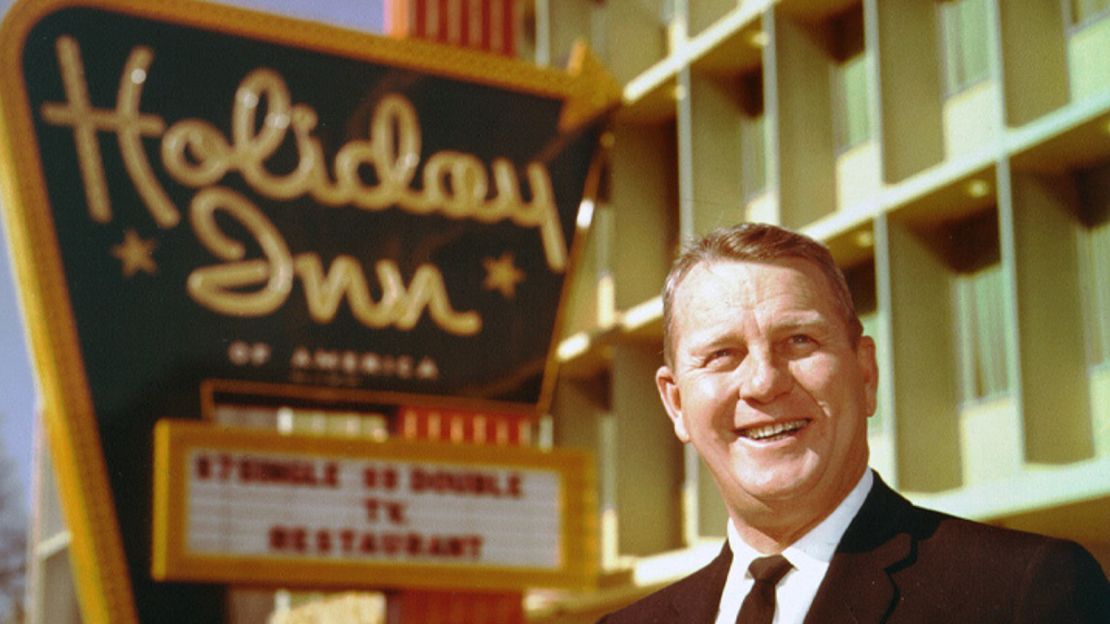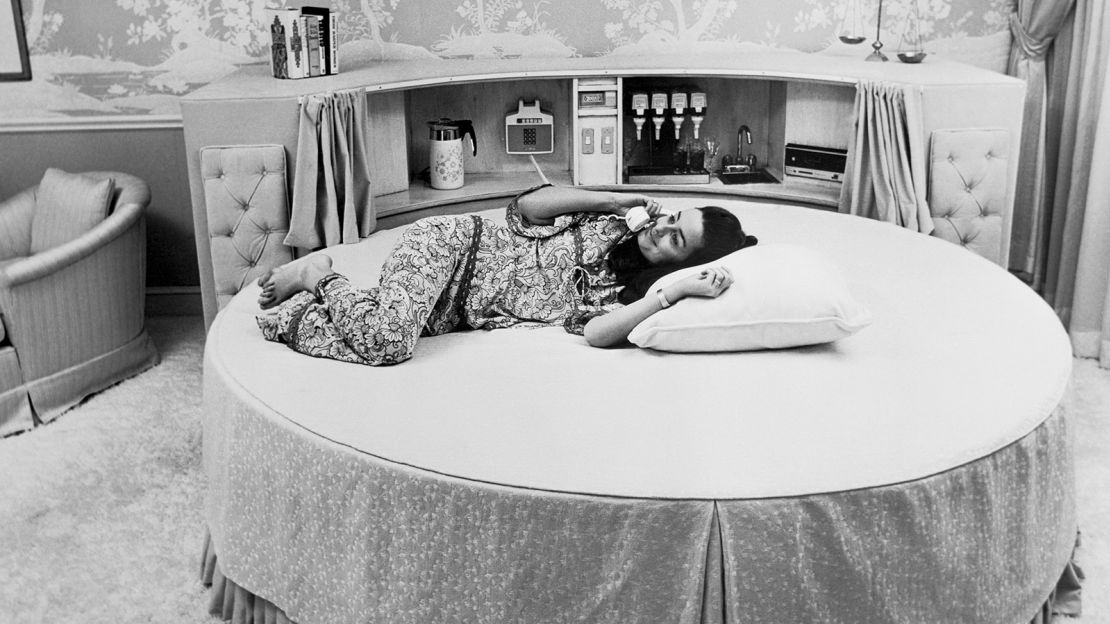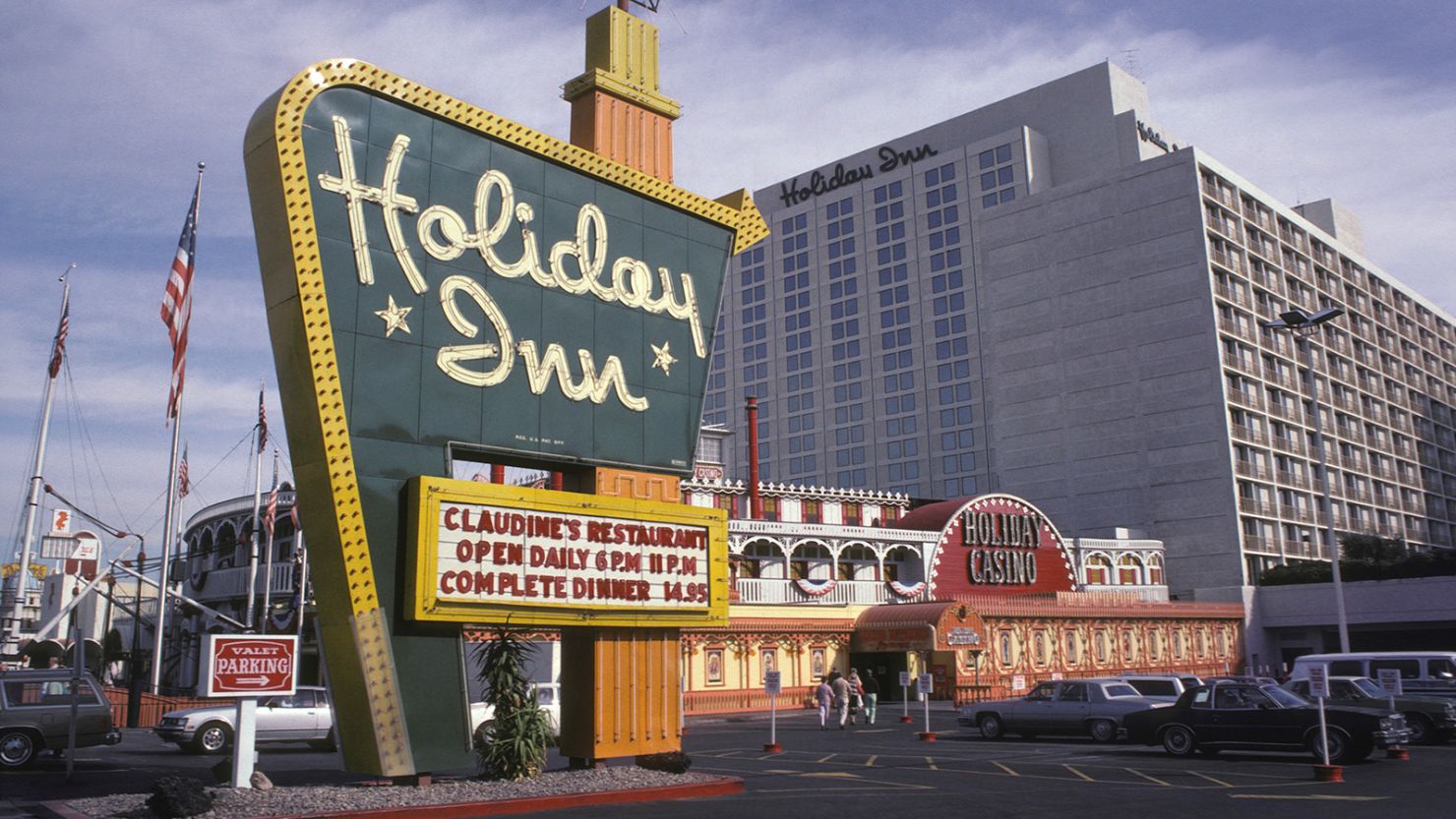Kemmons Wilson was ferrying his family from New York to Washington by car when the idea first came to him.
The Wilsons needed to stop for the night, but it was the summer of 1951, and American roadside facilities weren’t what they are today. Motels were luck of the draw, and often expensive given the lack of amenities.
“Rooms were never quite as advertised, so [my father] would get a key and go take a look at the room before we signed up for it,” recalls Kemmons’ oldest child, Spence Wilson, today.
“Many of the things that we think of today as just standards, well, they weren’t standards back then.”
On this particular East Coast road trip, Kemmons, a father of five and an entrepreneur, started dreaming about a simple, family-friendly motel that would offer every necessary amenity. There wouldn’t just be one. There would be hundreds, dotted up and down US roads.
No matter the state, whatever the highway, you could pull up at this hotel and know exactly what you were getting.
The idea was simple – no frills, just clean, accommodation with a restaurant, plenty of rooms and a pool. (“We always liked to swim, and so we were always clamoring for him to find a place that had a pool,” Spence Wilson tells CNN Travel). Children under 12 who shared rooms with parents would be able to stay for free.
In August 1952, Kemmons Wilson followed through on this dream, opening the first ever Holiday Inn. Seventy years later, the Holiday Inn brand is still going strong.
Today, low-cost roadside hotels are commonplace, but back in the 1950s, Kemmons’ concept was “truly revolutionary,” as Ross Walton, a historian for the University of Southern Mississippi Center for Oral History and Cultural Heritage, puts it.
“Wilson put together this package of ideas of what kind of amenities that the business traveler and vacationing families would want,” Walton tells CNN Travel. “Things that were upcharges anywhere else, he made them all standard, at a very reasonable room rate.”
Revolutionizing the motel

Kemmons opened the first ever Holiday Inn in his home city of Memphis, Tennessee. His children were involved in the opening ceremony.
“The mayor, who was supposed to come and cut the ribbon, didn’t show. Dad was not happy about that,” recalls Spence. “Then Mother said, ‘Well look, Kemmons, the kids are all dressed up, just have them cut the ribbon.’”
This first Holiday Inn was followed by three other Memphis-based outposts, built in collaboration with Kemmons’ co-founder, businessman Wallace E Johnson.
By the time the fourth Holiday Inn opened, a 1953 St Louis Post Dispatch article declared the then-prevailing image of a motel – “a group of shabby cabins huddled by a roadside” – to be a thing of the past.
More Holiday Inns followed. The company started a franchising model, whereby independent parties were permitted to open and operate Holiday Inn branches.
George Falls, a former Holiday Inn vice president, recalls traveling the length and breadth of the US – and later across seas – to look at potential sites and assess their viability for franchising.
“It was exhilarating,” Falls tells CNN Travel.
“I look back now – and look at some periodicals and annual reports and all – and I just can’t believe it grew so big, so rapidly, and particularly in the 60s.”
Falls and his team were responsible for making sure each site met Holiday Inn’s meticulous standards.
“Consistency was the name of the game – because the rooms were all the same size, they were all furnished the same way, and they had the same standard everywhere you went,” explains Falls, who recalls quarterly inspections to make sure motels were up to scratch.
“They were the same – and that’s what makes a chain work.”
The Great Sign

Kemmons Wilson understood that marketing was key to getting his idea off the ground, so Holiday Inn’s family-focused, road trip origin story was omnipresent in the brand’s PR from day one.
Motels had a less than wholesome reputation in the 1950s, and Kemmons, a Christian, wanted to overturn this image – one of Holiday Inn’s staples was a bible in every room.
Kemmons also emphasized his humble beginnings as a high school dropout brought up by a single mother in the Great Depression of the 1920s.
It helped that the chain also had a catchy name, credited to the brand’s architect Eddie Bluestein, who inscribed “Holiday Inn” onto his design sketches of the first Memphis-based motel.
Bluestein was inspired by the 1942 movie musical of the same name starring Bing Crosby and Fred Astaire. Kemmons liked the name and so it stuck.
Holiday Inn also successfully enticed would-be guests in from the highway via the “Great Sign” – a neon-colored, striking edifice designed by artists Gene Barber and Roland Alexander.
The sign, which towered some 50 feet high, was eye-catching in green, yellow and red, embellished with flashing light bulbs. According to Spence, each sign used enough electricity to power five residential houses.
Spence suggests cinema provided the inspiration for the sign’s aesthetic – after all, Kemmons had once owned a chain of movie theaters.
“I think it was as exciting to business people as it was to families to ride down the road and see that sign, and pull in and be so fully satisfied and finding everything they could possibly want,” says former vice president Falls.
It was also important to Kemmons that Holiday Inns should never display a “no vacancy” sign, even if there was no space.
“If the hotel was full, they would find you [an alternative] place to stay,” says Spence.
Spence worked in a Holiday Inn during a college summer vacation. He recalls Kemmons dropping by, and when he saw staff turning away prospective guests, stepping in and phoning some 30 nearby hotels until he secured the travelers alternative accommodation.
The Great Sign was retired in the 1980s, shortly after Kemmons own retirement. Spence says his father was “disappointed” but understood this was a cost-efficient move, and that times were changing.
“He was not a man who looked in the past much,” says Spence of his father, who passed away aged 90 in 2003.
IHG Hotels & Resorts, the hotel group that now owns the Holiday Inn brand, suggests the legacy of the Great Sign continues today.
“While the Great Sign isn’t making a comeback per se, we are paying homage to it through our color palette, wall art, and accent pieces,” Jennifer Gribble, senior vice president global marketing mainstream brands for IHG Hotels & Resorts, tells CNN Travel. “The keen observer will be able to find hints of it throughout our designs.”
Creating a modern hotel
Holiday Inn championed many concepts that were unusual in the 1950s, but later became commonplace – ice machines in every hallway, televisions in every room and onsite restaurants, to name just a few.
In 1965, the company debuted “Holidex”, an internal computer reservation system created by IBM.
Holidex allowed guests to instantaneously book rooms at any Holiday Inn across the US. In 1965, it was the world’s largest commercial computerized communications network.
“Once that system came into being, Dad said it made selling franchises like selling candy on the street corner,” recalls Spence.
“I would say no one else had anything like it,” agrees historian Ross Walton. “Holiday Inn was the undisputed leader at that point – and that was 10 years into the history of the company.”
In the 1970s, Holiday Inn also premiered the Holiday Inn Holidome concept – a climate-controlled indoor space that housed attractions such as tiki bars to indoor swimming pools.
In 1972, the six roomed master suite at the Holiday Inn in the city of Gaithersberg, Maryland, was touted as the then most expensive suite at any US motel, at a reported $1,400 a night. The franchise owner built the room to entice famous faces, and celebrities including Cher reportedly stayed there.
Early Holiday Inns also offered more practical on-site amenities, including pharmacies, dress stores and gift shops that sold everything from Holiday Inn-branded steak sauce to trampolines.
“The idea was you wanted the customer to get there and stay there, and whatever they needed, they could buy it right there on the premises without having to go somewhere else and spend that money elsewhere. So it’s convenient for the customer, and it was profitable for the franchise holder,” says Walton.

The focus wasn’t just on creating an on-site community. The aim was each Holiday Inn’s outpost would become a firm part of the existing community.
That’s something George Falls recalls from his days traveling across the US to help establish new Holiday Inns.
“The small towns we would go into – and they’d be towns of 20,000 people sometimes – the thing they wanted the most was a restaurant and a place for people to meet,” says Falls.
“So [the restaurant] became the sort of central meeting place for a lot of communities, and that was kind of a thrill to see that happen, and to see it become a part of the small town.”
Falls fondly remembers local buzz each time a Holiday Inn opened its doors.
“We had a grand opening in each one, and that would really bring about excitement in the community,” he says. “It was vibrant, with that big sign out front – it was just a big happening, and we made the most of it.”
Mark Stansbury, who became Holiday Inn’s community relations manager in 1969, has fond memories of one particular grand opening.
Stansbury was, in his words, “one of the first African Americans, not pushing a broom or mop” to be hired by Holiday Inn.
Four years after he got the job, Stansbury was in attendance at the 1973 opening of Holiday Inn’s first wholly Black-owned franchise in Tuskegee, Alabama.
Stansbury is also a photographer – he counts Martin Luther King, Jr., Elvis Presley, The Beatles and Rosa Parks among his former subjects – so he photographed the opening of the Tuskegee, Alabama Holiday Inn.
“It was wonderful knowing that I was photographing history in the making,” Stansbury tells CNN Travel.
Changing times

As time went on and the brand grew – with rival brands like Sheraton and Marriott hot on its heels – Holiday Inn continued to expand.
Kemmons Wilson appeared on the June 12, 1972 edition of Time Magazine – under the headline: “The Man with 300,000 Beds.”
The magazine reported that in 1972, Kemmons operated 1,405 inns in 50 states and 20 foreign countries or territories, including Switzerland, Hong Kong and Morocco. According to IHG Hotels & Resorts, at this time Holiday Inn opened a new hotel every three days.
Wilson also built motels in what was then the Soviet Union.
“I think we can do more for world peace through tourism and building Holiday Inns around the world than anything else,” said Kemmons in his Time interview. “We get to know other people and they get to know us and that’s good.”
George Falls would travel across the world to help establish new Holiday Inns.
“We tried to use our same standards all over the world,” recalls Falls. “Sometimes it was hard.”
Some countries were less keen on the Great Sign, says Falls. Plus there were different cultural norms in different countries.
“Like in England, for example – they weren’t used to the big rooms we had, and certainly weren’t used to the bathrooms,” recalls Falls.
New era
After Kemmons retired in 1979, the Holiday Inn brand went through some ups and downs and different owners.
Today, under IHG Hotels & Resorts, there are some 1,200 Holiday Inns worldwide. There are several subsidiaries, including Holiday Inn Express, which offers a stripped-down version of the Holiday Inn experience.
The Wilson family is also still involved, albeit indirectly, via their affiliated resort and timeshare business, Holiday Inn Club Vacations.
George Falls says he still regularly stays in Holiday Inns with his family on his travels. Usually the family opt for a Holiday Inn Express, but Falls has a particular fondness for the larger, original Holiday Inns – many of which he helped establish.
“I take a little pride in when I drive by one,” says Falls.
